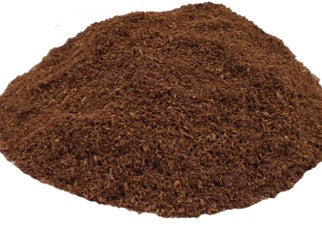
What makes Coco Peat (Coconut Husk Peat) a great choice for Spill Absorbent?
Coconut Husk Peat (variously known in US as Coco Coir Peat, Coco Peat, Coco Coir, Coir Pith, Coco Soil, Coconut Fiber Dust etc.,) is the non-fibrous, spongy, light weight, corky material that holds together the coir fiber in coconut husk. It is a 100% organic and natural substance. It is obtained as a byproduct in the process of extracting Coconut Fiber from the husk. Let’s call it by the term Coco Peat in this article.
While being essentially a waste product from the coconut industry this material was at one point considered a nuisance in the industry since people didn’t know how to dispose of this dusty stuff. Once someone figured out its utility as a soil alternative in farming and horticulture, it quickly spread in popularity. It is now exported in large volumes from the coconut producing countries to the West for this purpose.
Ability to Adsorb and Absorb
The characteristic that made it popular as a soil alternative – its ability to absorb and hold large quantities of water – is what makes it a great choice as a spill absorbent too. A typical sorbent does its job by ‘adsorption’ or ‘absorption’ or both. Adsorption is the process in which the liquid molecules first diffuse and adhere to the surface of the sorbent material. The substance adsorbed onto the surface is called the adsorbate. The substance with the surface is called the adsorbent. Absorption occurs when ions, atoms, or molecules pass into a bulky material. These particles (the absorbate) dissolve into the absorbent substance.
Coco Peat does the job by the process of adsorption as well as absorption. In the case of oil, the oil molecules first diffuse onto the surface of the Coco Peat particles (‘adsorption’). These oil molecules then get entrapped in the pores of Coco Peat particles due to capillary effects and finally agglomerate (‘absorption’). This is possible due to the unique microstructure of the Coco Peat particles.
The images below show the structure of the Coco Peat particle as seen with Scanning Electron Microscope.


Ability to hold absorbed liquid from leaching out
This type of microstructure enables Coco Peat to not only adsorb and absorb large amounts of liquid (6 to 11 times by weight) but also to hold the liquid so that it doesn’t leach back. This is an important requirement for spill absorbents to meet.
Non-Biodegradability or Slow Biodegradability
It is also necessary for the absorbent to not biodegrade quickly so that the absorbed liquid material doesn’t go back into the landfill. Coir Peat (when processed and formulated properly for this purpose) biodegrades very slowly. EPA has defined a test method (OECD test 301B: - CO Evolution Test) for this purpose. OECD 301B is an aerobic biodegradation test that introduces a material to an inoculum in a closed environment and measures biodegradation of the material by CO2 evolution.
OECD 301B uses respirometry to determine the biodegradability of the material by evaluating the production of CO2 over a minimum of 28 days in a liquid environment.
Insolubility
A liquid spill absorbent should not be soluble in the liquid it is meant to absorb. Also, it should not dissolve in water (for use as an absorbent for oil or similar spills in water). Coco Peat meets this requirement.
Buoyancy
Obviously, if we are dealing with liquid spills in water, the absorbent material needs to be able to float so that it can be removed from the water body. Coco Peat has particle density and bulk density such that it always floats in water.
Non-Reactivity
A liquid spill absorbent shouldn’t react with the material it is supposed to absorb. Coco Peat is very non-reactive. Using the wrong absorbent with corrosive liquids can cause unwanted heat reactions and other safety hazards. When working with corrosives, it is important to choose absorbent materials that will not react with the material being absorbed.
Toxicity
The spill absorbent should not be toxic or add to the toxicity of the material being absorbed.
TCLP is one of the test methods that is utilized when characterizing waste as either hazardous or non-hazardous as defined in the Code of Federal Regulations; RCRA 40 CFR Part 261. The term TCLP is an acronym for Toxicity Characteristic Leaching Procedure. This analysis simulates conditions within a landfill and determines which of the contaminants identified by the United States Environmental Protection Agency (EPA) are present in the leachate as well as their concentrations. Over time, water and liquid waste percolates through landfills. The solid waste that you are depositing can potentially react with the percolating liquid, posing environmental health risks from the contaminants it absorbs. A TCLP analysis determines which of the contaminants identified by the EPA are present in the leachate and their concentrations.
Physical Characteristics
Coco Peat is very light due to its low particle density as well as low bulk density compared to clay based spill absorbents. These properties make it very convenient to carry around and apply. It saves significant costs in logistics.
It can be seen easily that Coco Peat (Coconut Husk Peat) ticks all the boxes when it comes to application as a spill absorbent. Being completely natural and plant based is an added bonus.
